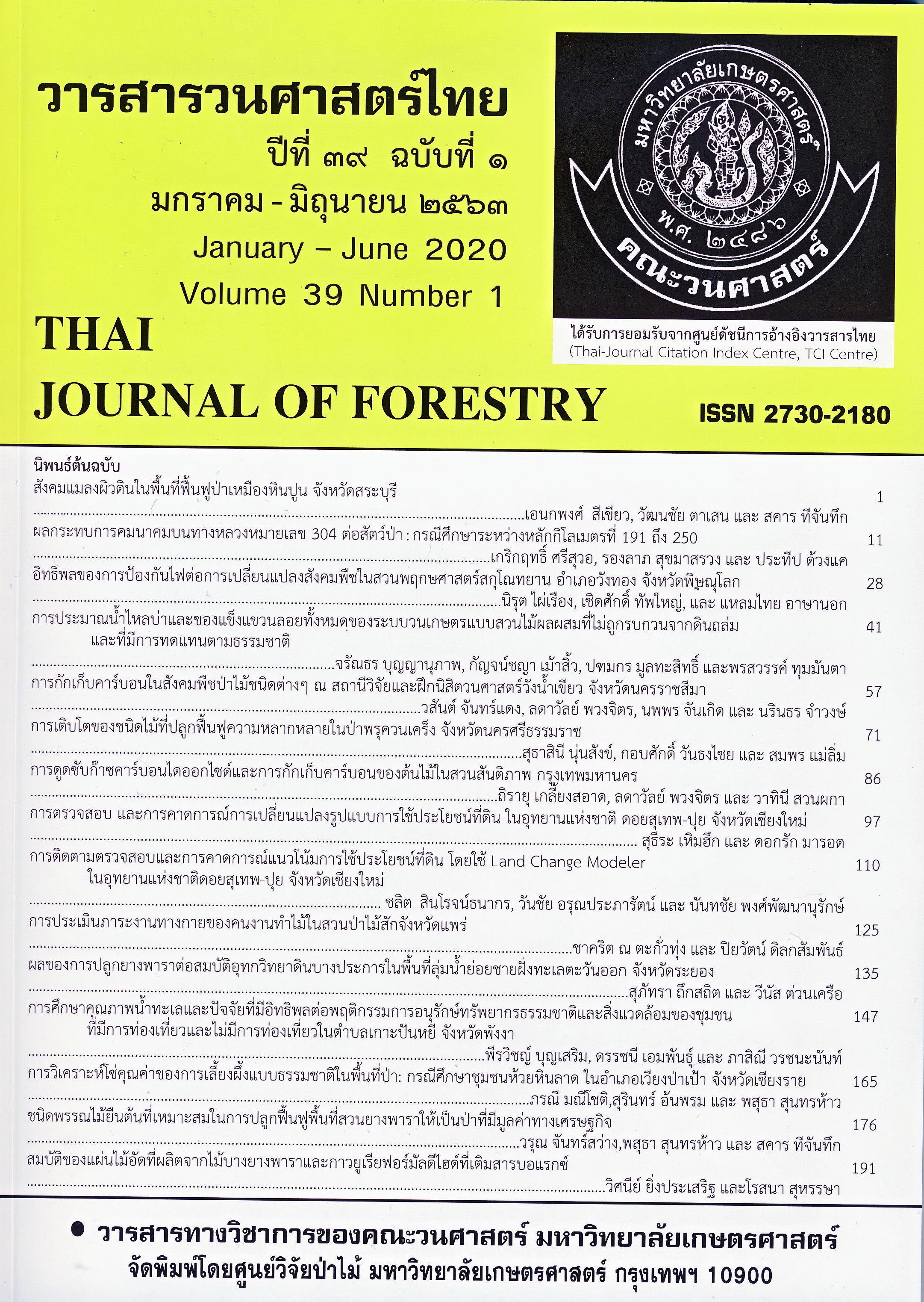การติดตามตรวจสอบและการคาดการณ์แนวโน้มการใช้ประโยชน์ที่ดิน โดยใช้ Land Change Modeler ในอุทยานแห่งชาติดอยสุเทพ-ปุย จังหวัดเชียงใหม่
Main Article Content
บทคัดย่อ
การศึกษาครั้งนี้มีวัตถุประสงค์เพื่อจำแนกรูปแบบการเปลี่ยนแปลงการใช้ประโยชน์ที่ดินในเขตอุทยานแห่งชาติดอยสุเทพ-ปุย จังหวัดเชียงใหม่ ในช่วงปี พ.ศ. 2552-2556 และ พ.ศ. 2556-2560 และเพื่อคาดการณ์แนวโน้มการใช้ประโยชน์ที่ดินในปี พ.ศ. 2564 ด้วยวิธีการแปลตีความจากข้อมูลดาวเทียมไทยโชต และประยุกต์ใช้ระบบสารสนเทศภูมิศาสตร์ รวมทั้งแบบจำลองการเปลี่ยนแปลง
การใช้ประโยชน์ที่ดิน (Land Change Modeler หรือ LCM) โดยกำหนดปัจจัยสิ่งแวดล้อมที่อาจส่งผลกระทบต่อการเปลี่ยนแปลงสภาพการใช้ประโยชน์ที่ดินเป็นตัวแปรขับเคลื่อน (driver variables) ประกอบด้วย ความลาดชัน แหล่งน้ำ เส้นทางคมนาคม ชุมชนและ
สิ่งปลูกสร้าง ระยะห่างจากเส้นทางคมนาคม ระยะห่างจากแหล่งน้ำ
จากการศึกษาพบว่า ในปี พ.ศ. 2560 รูปแบบการใช้ประโยชน์ที่ดินในอุทยานแห่งชาติดอยสุเทพ-ปุย ประกอบด้วยพื้นที่ป่าไม้ ไม้ผล/ไม้ยืนต้น เกษตรผสมผสาน ชุมชนและสิ่งปลูกสร้าง พื้นที่เบ็ดเตล็ด และแหล่งน้ำ ร้อยละ 85.48, 9.77, 0.91, 1.61, 2.12 และ 0.11 ตามลำดับ โดยมีค่าความถูกต้องรวมของการจำแนกในรูปแบบของ confusion matrix คิดเป็นร้อยละ 91.91 การเปลี่ยนแปลงการใช้ประโยชน์ที่ดินในช่วงปี พ.ศ. 2552-2556 มีการเปลี่ยนแปลงของพื้นที่ทั้งหมด 8.24 ตารางกิโลเมตร (ตร.กม.) โดยพื้นที่ป่าไม้ เกษตรผสมผสาน ชุมชนและสิ่งปลูกสร้าง และแหล่งน้ำ มีพื้นที่เพิ่มขึ้นร้อยละ 32.89, 3.03, 13.47 และ 0.61 ตามลำดับ ส่วนพื้นที่เบ็ดเตล็ดและไม้ผล/ไม้ยืนต้น ลดลงร้อยละ 7.29 และ 42.71 ตามลำดับ ในขณะที่การใช้ประโยชน์ที่ดินในช่วงปี พ.ศ. 2556-2560 มีการเปลี่ยนแปลงของพื้นที่ทั้งหมด 17.46 ตร.กม. โดยพื้นที่ไม้ผล/ไม้ยืนต้น เกษตรผสมผสาน ชุมชนและสิ่งปลูกสร้าง และแหล่งน้ำ เพิ่มขึ้นร้อยละ 46.45, 0.74, 2.69 และ 0.12 ตามลำดับ ส่วนพื้นที่ป่าไม้และพื้นที่เบ็ดเตล็ด ลดลงร้อยละ 44.16 และ 5.84 ตามลำดับ
จากการคาดการณ์แนวโน้มการใช้ประโยชน์ที่ดินปี พ.ศ. 2564 พบว่า ในช่วงปี พ.ศ. 2560-2564 มีแนวโน้มการเปลี่ยนแปลงของพื้นที่ทั้งหมด 9.70 ตร.กม. โดยพื้นที่ไม้ผล/ไม้ยืนต้น เกษตรผสมผสาน ชุมชนและสิ่งปลูกสร้าง พื้นที่เบ็ดเตล็ด และแหล่งน้ำ
เพิ่มขึ้นร้อยละ 38.35, 3.09, 4.54, 3.81 และ 0.10 ตามลำดับ ในขณะที่พื้นที่ป่าไม้ลดลงร้อยละ 50.11 ทั้งนี้ เมื่อนำชั้นข้อมูลขอบเขตการปกครองระดับตำบลและชั้นข้อมูลที่ตั้งหมู่บ้าน/ชุมชนมาซ้อนทับบนชั้นข้อมูลการเปลี่ยนแปลงสภาพการใช้ประโยชน์ที่ดิน พ.ศ. 2560–2564 พบว่า อุทยานแห่งชาติดอยสุเทพ-ปุย จะต้องเฝ้าระวังพื้นที่ที่เสี่ยงต่อการเปลี่ยนแปลงพื้นที่ป่าไม้ไปเป็นพื้นที่เกษตรกรรมและอื่นๆ บริเวณรอยต่อระหว่างหมู่บ้านกับแนวเขตอุทยานแห่งชาติ ได้แก่ บ้านหนองบัวหลวง บ้านเอียก ของตำบลสันป่ายาง บ้านแม่แรม (หนองหอย) และบริเวณบ้านทุ่งแท่น ของตำบลแม่แรม บ้านหนองหอยเก่า บ้านหนองหอย (สามหลัง) บ้านโป่งแยงใน บ้านโป่งแยงนอก บ้านม่วงคำ และบ้านแม่สาน้อย ของตำบลโป่งแยง บ้านปางยาง บ้านห้วยลึก และบ้านเก๊าเดื่อ ของตำบลบ้านปง
Downloads
Article Details
ข้าพเจ้าและผู้เขียนร่วม (ถ้ามี) ขอรับรองว่า ต้นฉบับที่เสนอมานี้ยังไม่เคยได้รับการตีพิมพ์และไม่ได้อยู่ในระหว่างกระบวนการพิจารณาตีพิมพ์ลงในวารสารหรือสิ่งตีพิมพ์อื่นใด ข้าพเจ้าและผู้เขียนร่วม (ถ้ามี) ยอมรับหลักเกณฑ์และเงื่อนไขการพิจารณาต้นฉบับ ทั้งยินยอมให้กองบรรณาธิการมีสิทธิ์พิจารณาและตรวจแก้ต้นฉบับได้ตามที่เห็นสมควร พร้อมนี้ขอมอบลิขสิทธิ์ผลงานที่ได้รับการตีพิมพ์ให้แก่วารสารวนศาสตร์ คณะวนศาสตร์ มหาวิทยาลัยเกษตรศาสตร์ กรณีมีการฟ้องร้องเรื่องการละเมิดลิขสิทธิ์เกี่ยวกับภาพ กราฟ ข้อความส่วนใดส่วนหนึ่ง หรือ ข้อคิดเห็นที่ปรากฏในผลงาน ให้เป็นความรับผิดชอบของข้าพเจ้าและผู้เขียนร่วม (ถ้ามี) แต่เพียงฝ่ายเดียว และหากข้าพเจ้าและผู้เขียนร่วม (ถ้ามี) ประสงค์ถอนบทความในระหว่างกระบวนการพิจารณาของทางวารสาร ข้าพเจ้าและผู้เขียนร่วม (ถ้ามี) ยินดีรับผิดชอบค่าใช้จ่ายทั้งหมดที่เกิดขึ้นในกระบวนการพิจารณาบทความนั้น”
เอกสารอ้างอิง
Campbell, J.B. 1996. Introduction to Remote Sensing. Taylor & Francis, London.
Clark, L. 2013. IDRISI Spotlight: The Land Change Modeler. Clark University, Worcester, MA.
Grainger, A. 1990. Modeling deforestation in the humid tropics, pp. 51-67. In M. Palo and G. Mery, eds. Deforestation or Development in the Third World? Vol. 3 Bulletin No. 349. Finnish Forest Research Institute, Helsinki.
Lambin, E.F., B.L. Turner, H.J. Geist, S.B. Agbola, A. Angelsen, J.W. Bruce, O.T. Coomes, R. Dirzo, G. Fischer, C. Folke, P.S. George, K. Homewood, J. Imbernon, R. Leemans, X. Li, E.F. Moran, M. Mortimore, P.S. Ramakrishnan, J.F. Richards, H. Skånes, W. Steffen, G.D. Stone, U Svedin, T.A. Veldkamp, C. Vogel and J. Xu. 2001. The causes of land-use and land-cover change: moving beyond the myths. Global Environmental Change 11: 261-269.
Pongpattananurak, N. 2014. Prioritizing forest complexes of Thailand using landscape metrics. Thai Journal of Forestry 33(2): 61-76. (in Thai)
Turner Ii, B.L., D. Skole, S. Sanderson, G. Fischer, L. Fresco and R. Leemans. 1995. Land-use and land-cover change, science/research plan. IGBP Report No. 35/HDP Report No. 7. Stockholm.
Wannavichit, N. 2005. Transportation Development and Land Use Dynamics in Chiang Mai Urban Fringe. M.S. Thesis, Chiang Mai University. (in Thai)
Yardmak, P . 2012. Guideline for Ecological Landuse the Adjacent Area to Doi Suthep - Pui National Park, Amphoe Mueang and Amphoe Hang Dong Chiang Mai Province. M.S. Thesis, Kasetsart University.
(in Thai)


